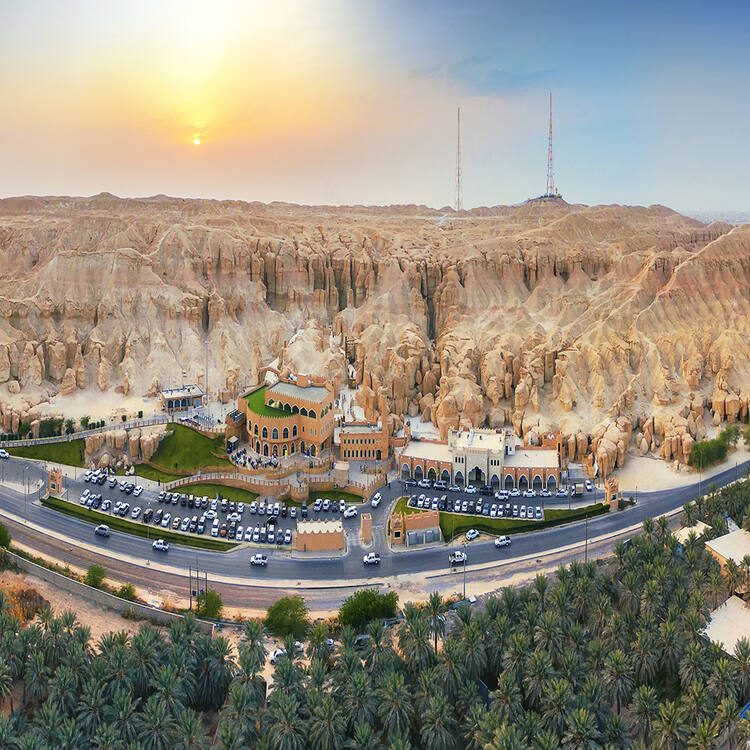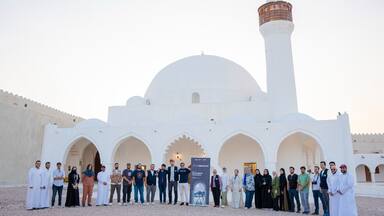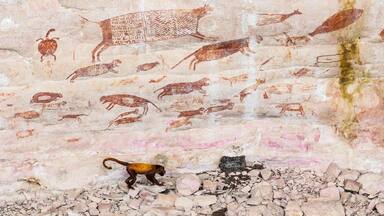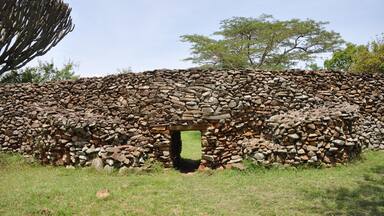Al-Ahsa Oasis, an Evolving Cultural Landscape
Al-Ahsa Oasis, an Evolving Cultural Landscape
In the eastern Arabian Peninsula, the Al-Ahsa Oasis is a serial property comprising gardens, canals, springs, wells and a drainage lake, as well as historical buildings, urban fabric and archaeological sites. They represent traces of continued human settlement in the Gulf region from the Neolithic to the present, as can be seen from remaining historic fortresses, mosques, wells, canals and other water management systems. With its 2.5 million date palms, it is the largest oasis in the world. Al-Ahsa is also a unique geocultural landscape and an exceptional example of human interaction with the environment.
Description is available under license CC-BY-SA IGO 3.0
Oasis d’Al-Ahsa, un paysage culturel en évolution
Située dans la partie orientale de la péninsule arabique, l'oasis d'Al-Ahsa est un bien en série qui comprend des jardins, des canaux, des sources, des puits, un lac de drainage, des bâtiments historiques, un tissu urbain et des sites archéologiques qui sont considérés comme représentant les traces d'une occupation humaine sédentaire dans la région du Golfe depuis la période néolithique jusqu'à nos jours. Cela se manifeste notamment par les forteresses historiques subsistantes, les mosquées, les sources, les canaux et autres dispositifs de gestion de l'eau. Avec ses 2,5 millions de palmiers, il s'agit de la plus vaste oasis au monde. Ce paysage géoculturel unique est aussi un exemple exceptionnel d'interaction humaine avec l'environnement.
Description is available under license CC-BY-SA IGO 3.0
واحة الأحساء، منظر ثقافي آخذ بالتغير
source: UNESCO/CPE
Description is available under license CC-BY-SA IGO 3.0
哈萨绿洲,变迁的文化景观
哈萨绿洲地处阿拉伯半岛东部,由花园、运河、泉眼、水井、排水湖,以及历史建筑、城市机构和考古遗址等一系列遗产组成。从留存至今的古堡、清真寺、水井、运河和其他水务系统可以看出,这里代表了海湾地区从新石器时代到现在持续人类定居的痕迹。这个世界上最大的绿洲拥有250万棵椰枣树。作为一处独特的地理文化景观,哈萨绿洲还是人类与环境相处的典范。
source: UNESCO/CPE
Description is available under license CC-BY-SA IGO 3.0
Оазис Аль-Ахса, меняющийся культурный ландшафт
source: UNESCO/CPE
Description is available under license CC-BY-SA IGO 3.0
Oasis de Al –Ahsa, un paisaje cultural en evolución
Situado en la parte oriental de la Península Arábiga, el oasis de Al-Ahsa es un sitio serial que comprende jardines, canales, manantiales, pozos, un lago de drenaje, edificios históricos, un tejido urbano y sitios arqueológicos que se considera representan huellas de ocupación humana sedentaria en la región del Golfo desde el Neolítico hasta nuestros días. Esto se manifiesta en particular en las fortalezas históricas subsistentes, las mezquitas, los manantiales, los canales y otros dispositivos de gestión del agua. Con 2,5 millones de palmeras, Al-Ahsa es el mayor oasis del mundo. Este paisaje geocultural único es un ejemplo excepcional de interacción humana con el medio ambiente.
source: UNESCO/CPE
Description is available under license CC-BY-SA IGO 3.0
Outstanding Universal Value
Brief synthesis
Al-Ahsa Oasis is located in the eastern part of the Arabian Peninsula, bordered on the north by Abqaiq province, on the east by the Gulf, on the west by the desert of Ad-Dahna and on the south by the desert of Ar-Rub' Al-Khali (the Empty Quarter). The oasis landscape that evolved over millennia presents a way of life typical of the Gulf region of the Arabian Peninsula. This cultural landscape consists of gardens, canals, springs, wells, an agricultural drainage lake, as well as historic buildings. Al-Ahsa Oasis is composed of twelve component parts forming the largest oasis in the world with more than 2.5 million palm trees, urban fabric and archaeological sites that represent the evolution of an ancient cultural tradition and the traces of sedentary human occupation in the Gulf region of the Arabian Peninsula from the Neolithic Period up to the present. The landscape of Al-Ahsa in the past and now represents the different phases of the oasis’s evolution and the interaction of natural and cultural heritage.
Criterion (iii): The continuity of the oasis agricultural tradition is represented by an organically evolved cultural landscape with an agricultural organization based upon the distribution of the spring water through a network of open-air canals. Al-Ahsa Oasis cultural landscape materializes the vivacity and modernity of this specific land-use tradition and shows its continuing relevance at the local and regional scale.
Criterion (iv): This large cultural landscape is composed of different zones covering the oasis’ gardens, mountains, caves, villages, mosques and springs, but also archaeological sites and a small section of the historic centre of Al-Hofuf with the main monuments embodying the political control over the area and its commercial role throughout the past centuries. The vestiges of the villages, fortresses, mosques, markets and houses, though often in a ruinous shape, preserve a complete catalogue of the architectural elements composing the urban settlement of Al-Ahsa from the early Islamic period to the Saudi Kingdom.
Criterion (v): The oasis is an outstanding example of traditional human settlement developed in a desert environment exemplifying the intimate link between landscape, natural resources and the human efforts to settle the land. The rich water table close to the surface permitted the growth of a large oasis settlement. Water was originating from surface springs and drawn from wells reaching the shallow water table. Some of these springs and wells are still visible in the site, living memory of the traditional farming techniques.
Integrity
The property shows the sustainable evolution of the oasis and of its associated human settlements, where the physical and functional relations between the natural landscape, the water springs, the water canalization system, the villages, and the cities create a continuously evolving human-created oasis environment. Al-Ahsa Oasis remains today the largest agricultural area in the Arabian Peninsula, and a working and living environment that has developed in direct continuity with its origins and its past.
The component parts of the property possess an evident topographical integrity presenting the ensemble of the elements that characterize and make an oasis possible: water springs, caves, mountains, flatlands, modern and historic canals and water lifting mechanisms, human settlements and natural drainage areas. The continuing use of the oasis as major agricultural zone where high-quality dates are produced and exported throughout the world, and the persistence of traditions and built elements from the past eras, are authentic in use preserving both the agricultural and the settlement / commercial integrity of the oasis functions.
Throughout the millennia, while constantly evolving, the integrity of relationships between the palm groves, the water sources and canals, the human settlements and the natural landscape has remained constant, adapting to the needs of the human societies that developed in the area. Water distribution and water abduction modifications in the past 40 years have aimed to maintain the very agricultural function of the oasis.
The extraordinary integrity of this urban / natural landscape can still be fully appreciated when observing from an elevated point the “sea” of palm trees and gardens that extends in every direction almost endlessly. The sheer size of the property permits to ensure the complete representation of all tangible attributes of the cultural landscape and of the social processes conveying its Outstanding Universal Value. The oasis constituting elements are contained within the boundaries of the property and clearly manifest their significance and exceptionality.
The unique scale of Al-Ahsa Oasis, the largest oasis in the world, is mirrored by the very size of the property, while its historic depth and the complexity of traditional oasis agricultural methods are represented by the major archaeological zones within the property, covering thousands of years of human settlement, and by the persistence of traditional oasis agricultural crops beside the dominant date palm, including the red rice variety typical of Al-Ahsa. The integrity of the property is reinforced by the continuity of human presence in the oasis villages and by the existence of both traditional historic souks (like Al-Qaysariyah in Al-Hofuf) and modern markets for the exchange of agricultural and handicrafts products of the oasis.
Landscape views and intangible attributes relating, for example, to food traditions, work songs and clothes contribute to expressing the property’s Outstanding Universal Value. All the integrity aspects (composition, relationships and functionality of attributes) necessary to sustain the Outstanding Universal Value are represented, and the serial site as a whole, with its component parts, allows the expression of the significance of the property to the highest degree.
Authenticity
The oasis was, and remains, a major source of agricultural crops, the most important of which is palm dates. Al-Ahsa oasis, with its different and interconnected sectors, was the largest oasis in the world and the largest producer of dates even before the 1960s and the introduction of “mass production” techniques. Palm dates are the main agricultural staple of Al-Ahsa oasis, local communities are involved in packaging and making use of modern technologies to assure the wide spread marketing and distribution of their product. The State Party supports grassroots organic farmers, and the Saudi Government graciously donates the surplus of palm dates from Al-Ahsa to the United Nations World Food Programme.
Strict regulations for farms permit developments only on the edges of roads and highways, as well as up to 15% of the agricultural parcel set in private farms for agricultural services or rural housing under the controls of the municipal building code. Moreover, a royal decree prevents the conversion of agricultural parcels into urban uses. In addition, development of the surrounding areas in Al-Asfar Lake is still under evaluation and has not been adopted nor developed.
Protection and management requirements
Al-Ahsa Oasis is protected under the Saudi Law of Antiquities, Museums and Urban Heritage, Royal Decree No. 9/M (dated, 09/01/1436 AH corresponding to 01/11/2014). The Antiquity Law introduces and details the concept of Urban Heritage protection, paving the way for effective protection of historic monuments and districts inside the Oasis. Article 46 of the law defines the coordination mechanism between relevant governmental entities pertaining to the protection and development of urban heritage areas.
Archaeological sites and listed historic buildings are also protected by the 09/01/1436 AH Law and are managed by the Saudi Commission for Heritage.
Environmental protection of the nominated property is covered by Articles 15, 16, 17 and 32 of the 1992 Basic Law of Governance (referred to as “the constitution of Saudi Arabia”).
Development is regulated by the Public Environmental Law (No. M/34 dated 16 October 2001).
Urban regulations on the local level are defined by Al-Ahsa 2030 Master Plan and the Indicative Plan Report for Al-Ahsa Metropolitan area (2014), which synchronizes studies, approval plans, and regulations that are issued by Ministry of Municipalities and Rural Affairs. The Plan protects agricultural land located within an urban context, which is relevant to component part As-Seef and buffer zones ii and iii.
The Ministry of Environment Water and Agriculture (MEWA) and its affiliate Al-Hassa Irrigation and Drainage Company (HIDC) regulate water management for landscape and agricultural lands. They function under the ‘Regulation Concerning the Protection of Water Sources’, issued by Royal Decree No. M/34 of year 1400 H/1979 AD.
The property is currently managed by five national level main stakeholders and ten local level main stakeholders. The ‘Oasis Higher Management Committee’ under the direction of Al-Ahsa Governor, which meets on a monthly basis, carries out the coordination of all stakeholders. A Management Scheme, formally approved by the Governor of Al-Ahsa, aims to better coordinate and integrate management mechanisms of the oasis at Municipal and Provincial levels on the one hand, and to coordinate field activities with the headquarters of the Ministry of Municipalities and Rural Affairs and the other relevant governmental entities on the other hand.
The Management Scheme consists of a ‘Higher Committee’ (HC) and a ‘Site Management Unit’ (SMU) based in Al-Ahsa Municipality. The Site Management Unit will take on the role of site manager and will be responsible for verifying all planning regulations for the property, its buffer zones and the larger urban and natural setting, in order to ensure their conformity with the requirements and principles of the World Heritage Convention. An independent ‘Scientific Committee’ will be established to provide technical advice to local leadership for the management of the property.
Within the framework of the Management Plan Guidelines, a number of initiatives for the conservation and development of the oasis have been identified such as: landscape initiatives, architectural and urban initiatives, archaeology and cultural initiatives. An Action Plan is to be completed. The Higher Committee will be responsible for overseeing the implementation of the Action Plan.
The intended development of a comprehensive strategy for the sustainable development of the oasis will include risk preparedness. The Site Management Unit will oversee the realization of the risk management strategy in coordination with national security and civil defence.
Sustainable cultural tourism strategy is one of the priorities of the site management plan, with the intention to offer a holistic presentation of the property including tangible and intangible aspects. It is part of a large-scale regional tourism plan for the Eastern Province and the Gulf coastal area.
The management plan foresees an important role for the civil society and local community in supporting the sustainable development and conservation of the property. The management of the oasis should include a specific component of studying, understanding, monitoring and conserving the biodiversity of the oasis as an integral part of its heritage protection and sustainability. The monitoring regime, once in place, could be improved by more precise periodicity.




